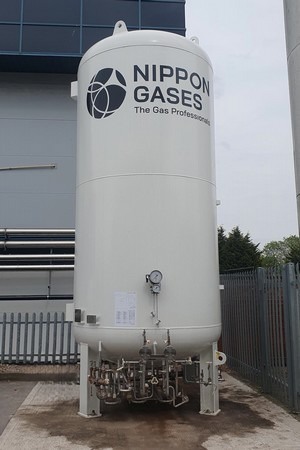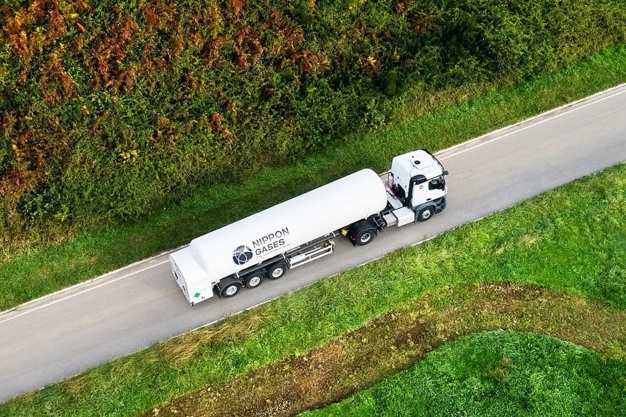CO2 enrichment in greenhouses enhances plant growth and increases yields. Mark Dziuba, Commercial Manager for Nippon Gases in the UK and Ireland, explains how his company, specializing in the industrial gases sector, supports horticultural production through its CO2 supply and technology. Nippon Gases is part of Nippon Sanso Holdings Corporation – the parent company to the Taiyo Nippon Sanso industrial gas business in Japan, the US Matheson Tri-Gas Group, the European Nippon Gases, the Asia/Oceania Regional Group and Thermos Business Group.
CO2: more than industrial applications
CO2 is often associated with carbon emissions and environmental concerns, but it also has beneficial uses in agriculture, particularly greenhouses. "We've got many different applications for CO2," said Mark. "One being for glasshouses in agriculture." He explained that since CO2 is an essential input for photosynthesis, the gas can significantly boost plant growth when properly managed in controlled environments such as greenhouses.
Mark highlighted the science behind CO2 enrichment: "When it is sunny and warm, higher CO2 levels enable plants to photosynthesize more efficiently. This leads to stronger plants and increased yields. The benefits are numerous."
Photo right: Nippon Gases CO2 vessel
CO2 supply chain and distribution
Nippon Gases has an extensive CO2 supply chain across Europe. In the UK and Ireland, the company sources CO2 from bioethanol fuel and ammonia production. The CO2 from these processes is captured, cleaned, liquefied, and stored for various uses, including carbonating products.
Mark outlined the logistics behind CO2 distribution: "We have three ships that we use to import our CO2, into our own terminals at Teesside, Tilbury, and Warrenpoint in Ireland. They're coming across the channel from our liquefication plants in Sluyskil in the Netherlands, and also from Osgren in Norway. We also produce CO2 on a large scale in the UK, ensuring customers have a reliable supply."

Nippon gases CO2 tanker
CO2 enrichment and horticulture
CO2 enrichment in greenhouses involves increasing the concentration of CO2 in the air to optimize plant growth. According to Mark, while the normal atmosphere has around 380 parts per million (ppm) of CO2, greenhouse environments can drop to much lower levels due to photosynthesis, reducing plant productivity. He noted, "When plants are photosynthesizing and the vents are closed, the CO2 levels inside the building can drop significantly, sometimes to around 150 to 200 parts per million."
For optimal growth, especially for C3 plants like tomatoes, CO2 levels of around 800 to 1,000 ppm are ideal. "C3 plants can have an increased yield of 40 to 100% if you increase the amount of CO2 in the atmosphere," Mark explained.
How CO2 enrichment works
Nippon Gases provides the infrastructure required for CO2 enrichment, which includes installing liquid CO2 storage tanks at customer sites. The CO2 is vaporized and injected into the greenhouse atmosphere, where it helps improve plant metabolic activity, increase final yields, and enhance plant resilience.
Mark explained the process in more detail: "We'd install a liquid CO2 storage tank at the customer's site and put vaporizers in place to turn it from liquid to gas. The glasshouse would then control how it injects that CO2 into the atmosphere, depending on factors like the time of year, whether the ventilation is open or closed, and whether it's sunny, daytime or nighttime, etc."
CO2 injection can also be automated and tailored to specific growing conditions, with sensors monitoring CO2 levels and adjusting the supply as needed. This ensures that plants receive optimal levels of CO2 for photosynthesis during daylight hours, enhancing growth while minimizing waste.
Sustainable CO2 use
Mark emphasized that the company's commitment to reducing its environmental footprint, aiming to become a net-zero producer by 2050. One way the company is addressing sustainability is by sourcing CO2 from bioethanol fuel production, which offers a more sustainable alternative to ammonia-based CO2 production.
He explained the circular nature of CO2 from bioethanol sources: "You're getting the CO2 from crop growth. We use the CO2, but eventually, it returns to the atmosphere, and the plants absorb it again. It's a circular economy."
By using bioethanol-derived CO2 Nippon Gases reduces their reliance on fossil fuels. The company plans to expand this model in the coming years, establishing additional CO2 sources in the UK from bioethanol fuel production.
Challenges and the future of CO2 supply
While the benefits of CO2 enrichment are clear, the industry faces challenges, particularly in maintaining a consistent supply chain. Mark highlighted some of these challenges, including the volatility of gas prices and the closure of ammonia production plants in the UK. He explained, "Ammonia production in the UK has ceased. CF Industries, which historically operated two ammonia plants in the UK, has shut them down. This means 400,000 tons of CO2 are no longer available in the UK and Ireland market."
Despite these challenges, Nippon Gases has managed to maintain a reliable supply of CO2 using its European network and importing CO2 from multiple sources. Mark concluded, "By using CO2 enrichment you are effectively giving the plants the best environment in which to grow, intending to increase productivity and yields with a stronger more resilient plant."
For more information:![]()
Nippon Gases
Mark Dziuba, Commercial Manager, UK & Ireland
mark.dziuba@nippongases.com
nippongases.com
